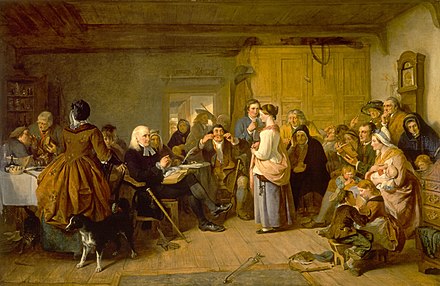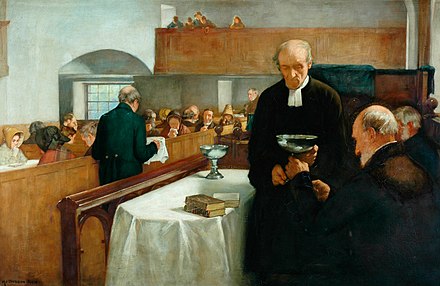
Presbyterianism is a Reformed (Calvinist) Protestant tradition named for its form of church government by representative assemblies of elders.[2] Though there are other Reformed churches that are structurally similar, the word Presbyterian is applied to churches that trace their roots to the Church of Scotland or to English Dissenter groups that formed during the English Civil War.[3]
Presbyterian theology typically emphasizes the sovereignty of God, the authority of the Scriptures, and the necessity of grace through faith in Christ. Presbyterian church government was ensured in Scotland by the Acts of Union in 1707,[4] which created the Kingdom of Great Britain. In fact, most Presbyterians found in England can trace a Scottish connection, and the Presbyterian denomination was also taken to North America, mostly by Scots and Scots-Irish immigrants. The Presbyterian denominations in Scotland hold to the Reformed theology of John Calvin and his immediate successors, although there is a range of theological views within contemporary Presbyterianism. Local congregations of churches which use Presbyterian polity are governed by sessions made up of representatives of the congregation (elders), a conciliar approach as with other levels of decision-making (presbytery, synod, and general assembly). There are roughly 75 million Presbyterians in the world.[5]
The roots of Presbyterianism lie in the Reformation of the 16th century, the example of John Calvin's Republic of Geneva being particularly influential. Most Reformed churches that trace their history back to Scotland are either presbyterian or congregationalist in government. In the 20th century, some Presbyterians played an important role in the ecumenical movement, including the World Council of Churches. Many Presbyterian denominations have found ways of working together with other Reformed denominations and Christians of other traditions, especially in the World Communion of Reformed Churches. Some Presbyterian churches have entered into unions with other churches, such as Congregationalists, Lutherans, Anglicans, and Methodists. Presbyterians in the United States came largely from Scottish, Scots-Irish immigrants, and also from New England communities that had originally been Congregational but changed because of an agreed-upon Plan of Union of 1801 for frontier areas.[6]

Presbyterian tradition, particularly that of the Church of Scotland, traces its early roots to the Christian Church founded by Saint Columba, through the 6th century Hiberno-Scottish mission.[7][8][9] Tracing their apostolic origin to Saint John,[10][11] the Culdees practiced Christian monasticism, a key feature of Celtic Christianity in the region, with a presbyter exercising "authority within the institution, while the different monastic institutions were independent of one another."[12][7][13] The Church in Scotland kept the Christian feast of Easter at a date different from the See of Rome and its monks used a unique style of tonsure.[14] The Synod of Whitby in 664, however, ended these distinctions as it ruled "that Easter would be celebrated according to the Roman date, not the Celtic date."[15] Although Roman influence came to dominate the Church in Scotland,[15] certain Celtic influences remained in the Scottish Church,[16] such as "the singing of metrical psalms, many of them set to old Celtic Christianity Scottish traditional and folk tunes", which later became a "distinctive part of Scottish Presbyterian worship".[17][18]

Presbyterian history is part of the history of Christianity, but the beginning of Presbyterianism as a distinct movement occurred during the 16th century Protestant Reformation. As the Catholic Church resisted the Reformers, several different theological movements splintered from the Church and bore different denominations.
Presbyterianism was especially influenced by the French theologian John Calvin, who is credited with the development of Reformed theology, and the work of John Knox, a Scottish Catholic Priest who studied with Calvin in Geneva and brought back Reformed teachings to Scotland. An important influence on the formation of presbyterianism in Britain also came from John a Lasco, a Polish reformer, the founder of a Stranger's Church in London, based on the Geneva models.[19]
The Presbyterian church traces its ancestry back primarily to Scotland. In August 1560, the Parliament of Scotland adopted the Scots Confession as the creed of the Scottish Kingdom. In December 1560, the First Book of Discipline was published, outlining important doctrinal issues but also establishing regulations for church government, including the creation of ten ecclesiastical districts with appointed superintendents which later became known as presbyteries.[20]
In time, the Scots Confession would be supplanted by the Westminster Confession of Faith, and the larger and shorter catechisms, which were formulated by the Westminster Assembly between 1643 and 1649.
Presbyterians distinguish themselves from other denominations by doctrine, institutional organisation (or "church order") and worship, often using a "Book of Order" to regulate common practice and order. The origins of the Presbyterian churches are in Calvinism. Many branches of Presbyterianism are remnants of previous splits from larger groups. Some of the splits have been due to doctrinal controversy, while some have been caused by disagreement concerning the degree to which those ordained to church office should be required to agree with the Westminster Confession of Faith, which historically serves as an important confessional document – second only to the Bible, yet directing particularities in the standardisation and translation of the Bible – in Presbyterian churches.
Presbyterians place great importance upon education and lifelong learning, tempered with the belief that no human action can affect salvation.
Continuous study of the scriptures, theological writings, and understanding and interpretation of church doctrine are embodied in several statements of faith and catechisms formally adopted by various branches of the church, often referred to as "subordinate standards".

Presbyterian government is by councils (still known as courts in some countries, as boards in others) of elders. Teaching and ruling elders are ordained and convene in the lowest council known as a session or consistory responsible for the discipline, nurture, and mission of the local congregation. Teaching elders (pastors or ministers) have responsibility for teaching, worship, and performing sacraments. Pastors or ministers are called by individual congregations. A congregation issues a call for the pastor or minister's service, but this call must be ratified by the local presbytery. The pastor or minister is a teaching elder, and Moderator of the Session, but is not usually a member of the congregation; instead, this person is a member of the Presbytery of which the given church is a member.
Ruling elders are elected by the congregation and ordained to serve with the teaching elders, assuming responsibility for the nurture and leadership of the congregation. Often, especially in larger congregations, the elders delegate the practicalities of buildings, finance, and temporal ministry to the needy in the congregation to a distinct group of officers (sometimes called deacons, which are ordained in some denominations). This group may variously be known as a "Deacon Board", "Board of Deacons" "Diaconate", or "Deacons' Court". These are sometimes known as "presbyters" to the full congregation. Since the 20th century, most denominations allow women to be teaching or ruling elders.
Above the sessions exist presbyteries, which have area responsibilities. These are composed of teaching elders and ruling elders from each of the constituent congregations. The presbytery sends representatives to a broader regional or national assembly, generally known as the General Assembly, although an intermediate level of a synod sometimes exists. This congregation / presbytery / synod / general assembly schema is based on the historical structure of the larger Presbyterian churches, such as the Church of Scotland or the Presbyterian Church (U.S.A.); some bodies, such as the Presbyterian Church in America and the Presbyterian Church in Ireland, skip one of the steps between congregation and General Assembly, and usually the step skipped is the Synod. The Church of Scotland abolished the Synod in 1993.[21]
Presbyterian governance is practiced by Presbyterian denominations and also by many other Reformed churches.[22]



Presbyterianism is historically a confessional tradition. This has two implications. The obvious one is that confessional churches express their faith in the form of "confessions of faith", which have some level of authoritative status. However this is based on a more subtle point: In confessional churches, theology is not solely an individual matter. While individuals are encouraged to understand Scripture, and may challenge the current institutional understanding, theology is carried out by the community as a whole. It is this community understanding of theology that is expressed in confessions.[24]
However, there has arisen a spectrum of approaches to confessionalism. The manner of subscription, or the degree to which the official standards establish the actual doctrine of the church, is a practical matter. That is, the decisions rendered in ordination and in the courts of the church largely determine what the church means, representing the whole, by its adherence to the doctrinal standard.
Some Presbyterian traditions adopt only the Westminster Confession of Faith as the doctrinal standard to which teaching elders are required to subscribe, in contrast to the Larger and Shorter catechisms, which are approved for use in instruction. Many Presbyterian denominations, especially in North America, have adopted all of the Westminster Standards as their standard of doctrine which is subordinate to the Bible. These documents are Calvinistic in their doctrinal orientation. The Presbyterian Church in Canada retains the Westminster Confession of Faith in its original form, while admitting the historical period in which it was written should be understood when it is read.
The Westminster Confession is "The principal subordinate standard of the Church of Scotland" but "with due regard to liberty of opinion in points which do not enter into the substance of the Faith" (V). This formulation represents many years of struggle over the extent to which the confession reflects the Word of God and the struggle of conscience of those who came to believe it did not fully do so (e.g. William Robertson Smith). Some Presbyterian Churches, such as the Free Church of Scotland, have no such "conscience clause".
The Presbyterian Church (U.S.A.) has adopted the Book of Confessions, which reflects the inclusion of other Reformed confessions in addition to the Westminster Standards. These other documents include ancient creedal statements (the Nicene Creed, the Apostles' Creed), 16th-century Reformed confessions (the Scots Confession, the Heidelberg Catechism, the Second Helvetic Confession), and 20th century documents (The Theological Declaration of Barmen, Confession of 1967 and A Brief Statement of Faith).
The Presbyterian Church in Canada developed the confessional document Living Faith (1984) and retains it as a subordinate standard of the denomination. It is confessional in format, yet like the Westminster Confession, draws attention back to original Bible text.
Presbyterians in Ireland who rejected Calvinism and the Westminster Confessions formed the Non-subscribing Presbyterian Church of Ireland.
John Gresham Machen, the prominent Presbyterian theologian and Professor of New Testament at Princeton Seminary between 1906 and 1929, led a revolt against modernist doctrine in his Christianity and Liberalism (1923) that critiqued theological modernism. He argued that modernism and liberal theology was a false religion, a pretender that cloaks itself in Christian language – "Liberalism". This religion is a marriage of naturalism, humanism, secularism, and sentimentalism all rolled into one.


Presbyterian denominations that trace their heritage to the British Isles usually organise their church services inspired by the principles in the Directory of Public Worship, developed by the Westminster Assembly in the 1640s. This directory documented Reformed worship practices and theology adopted and developed over the preceding century by British Puritans, initially guided by John Calvin and John Knox. It was enacted as law by the Scottish Parliament, and became one of the foundational documents of Presbyterian church legislation elsewhere.
Historically, the driving principle in the development of the standards of Presbyterian worship is the Regulative principle of worship, which specifies that (in worship), what is not commanded is forbidden.[25]
Over subsequent centuries, many Presbyterian churches modified these prescriptions by introducing hymnody, instrumental accompaniment, and ceremonial vestments into worship. However, there is not one fixed "Presbyterian" worship style. Although there are set services for the Lord's Day in keeping with first-day Sabbatarianism,[26] one can find a service to be evangelical and even revivalist in tone (especially in some conservative denominations), or strongly liturgical, approximating the practices of Lutheranism or more of Anglicanism,[clarification needed] or semi-formal, allowing for a balance of hymns, preaching, and congregational participation (favored by many American Presbyterians). Most Presbyterian churches follow the traditional liturgical year and observe the traditional holidays, holy seasons, such as Advent, Christmas, Ash Wednesday, Holy Week, Easter, Pentecost, etc. They also make use of the appropriate seasonal liturgical colors, etc. Many incorporate ancient liturgical prayers and responses into the communion services and follow a daily, seasonal, and festival lectionary. Other Presbyterians, however, such as the Reformed Presbyterians, would practice a cappella exclusive psalmody, as well as eschew the celebration of holy days.
Among the paleo-orthodox and emerging church movements in Protestant and evangelical churches, in which some Presbyterians are involved, clergy are moving away from the traditional black Geneva gown to such vestments as the alb and chasuble, but also cassock and surplice (typically a full-length Old English style surplice which resembles the Celtic alb, an ungirdled liturgical tunic of the old Gallican Rite), which some, particularly those identifying with the Liturgical Renewal Movement, hold to be more ancient and representative of a more ecumenical past.
Presbyterians traditionally have held the Worship position that there are only two sacraments:

